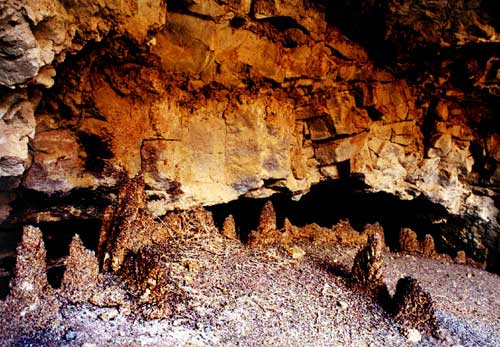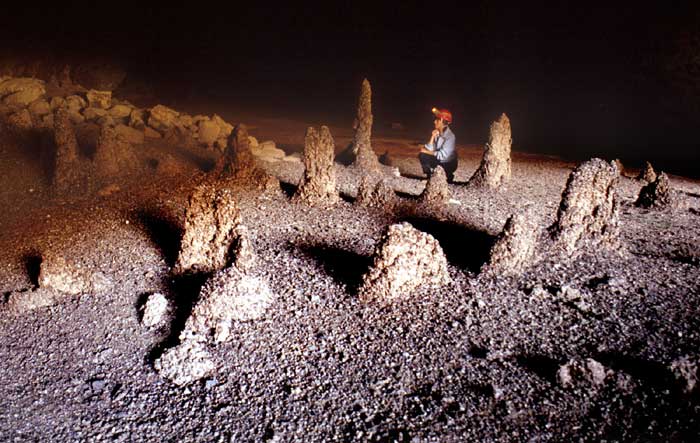|
 A few years ago,
John Pint, an experienced speleologist working for the Saudi Geological
Survey, lowered himself into a lava tube known as the Ghostly Cave in
the Harrat Kishb, a barren desert region in the central Arabian
Peninsula, and became the discoverer of a new biogeological
phenomenon. Before him lay a field of ‘stalagmites’, some as
tall as a man, that were in fact towers made of guano. Rock
doves (Columba livia)
use the roof of the cave as a roost and nesting site, and over the
years their accumulating droppings formed the structures that John gave
the name of guanomites. A few years ago,
John Pint, an experienced speleologist working for the Saudi Geological
Survey, lowered himself into a lava tube known as the Ghostly Cave in
the Harrat Kishb, a barren desert region in the central Arabian
Peninsula, and became the discoverer of a new biogeological
phenomenon. Before him lay a field of ‘stalagmites’, some as
tall as a man, that were in fact towers made of guano. Rock
doves (Columba livia)
use the roof of the cave as a roost and nesting site, and over the
years their accumulating droppings formed the structures that John gave
the name of guanomites.

A few of 50 or so guanomites
inside Ghostly Cave. Note the remains of an old rock wall in the
background.
No-one knows anything
about them. How old are they? How long do they take
to form – tens or hundreds of years? Have they become
mineralised? Are they porous? How compact are
they? Do they contain pollen grains or traces of vegetation
that might give an idea of what the birds fed on? If they do
contain such items, what does that tell us about where the birds fed
and how far they fly to find food (there is none nearby)?
What can the contents and mineralogy of guanomites tell us about bygone
climatic conditions?
An informal collaboration – The Guanomite Group - between scientists,
cave explorers and communicators across four countries is now trying to
answer these questions.
- John Pint
- speleologist and discoverer of guanomites (Mexico)
- Felix López –
chemist, Spanish Council for Scientific Research (CSIC) (Spain)
- Eduardo Barrón –
palynologist/botanist, Geomining Institute of Spain (Spain)
- Rafael López –
geologist, mineralogist, Geomining Institute of Spain (Spain)
- Daniel Haag-Wackernagel,
pigeon ecologist, University of Basel (Switzerland)
- Sigurjon Jonsson –
geophysicist, King Abdullah University of Science and Technology (Saudi
Arabia)
- Adrian Burton –
biologist, science writer and editor (Spain)
 If
you think your experience can help us, please contact us at
[email protected] and, of course, you are welcome to join G2R. If
you think your experience can help us, please contact us at
[email protected] and, of course, you are welcome to join G2R.
Watch this space for information on these intriguing structures as our
work progresses.
Literature available
1 Roobol MJ,. Pint J.J,. Al-Shanti M.A,. Al-Juaid A.J,. Al-Amoudi S.A,
and Pint S. 2002. Preliminary survey for lava-tube caves on Harrat
Kishb, Kingdom Of Saudi Arabia, Suadi Geological Survey, Open-File
Report SGS-OF 2002-2003. Available here.
2. Jennings MC. 2008. Birds in
caves. Phoenix 24: 13-14 [Contact Warners Farm Ho., Warners
Drove, Somersham, Cambs PE28 3WD, UK.]
3. Burton A. 2012. Goblins
of the Harrat Kishb. Frontiers in Ecology and the Environment
10: 452–452.
|

